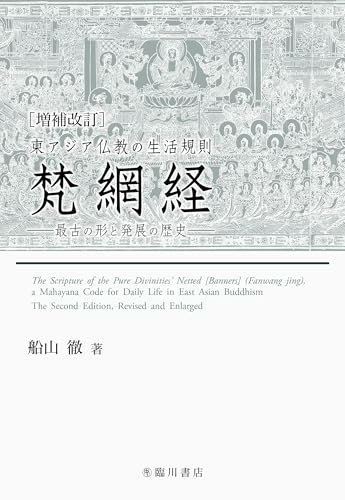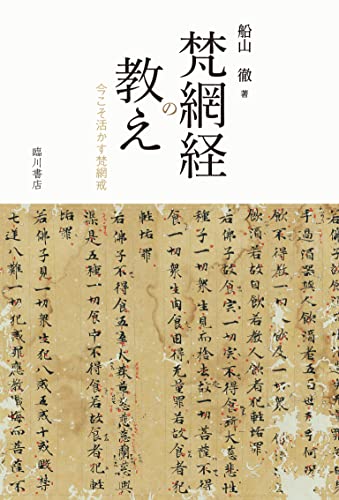6 0 0 0 OA インド仏教論理学の東アジア世界における受容と展開――因明学の再評価を目指して
本研究は,インド・チベット仏教における仏教認識論・論理学研究の成果と東アジアで展開した因明学の成果とを架橋することで,言語や文化の壁を越えて継承・変容した仏教認識論・論理学の特質を明らかにすることを目的とした。その主たる成果は,第18回国際仏教学会(IABS)のパネル“Transmission and Transformation of Buddhist Logic and Epistemology in East Asia” での発表と討議に結実しており,近くWiener Studien zur Tibetologie und Buddhismuskund シリーズから出版予定である。
6 0 0 0 OA 六朝時代における菩薩戒の受容過程 - 劉宋・南齊期を中心に -
- 著者
- 船山 徹
- 出版者
- 京都大學人文科學研究所
- 雑誌
- 東方學報 (ISSN:03042448)
- 巻号頁・発行日
- vol.67, pp.1-135, 1995-03-30
6 0 0 0 OA 眞諦三藏硏究論集
- 著者
- 船山 徹
- 出版者
- 京都大學人文科學硏究所
- 巻号頁・発行日
- 2012-03-25
序
5 0 0 0 仏教学デジタル知識基盤の継承と発展
- 著者
- 下田 正弘 蓑輪 顕量 永崎 研宣 大向 一輝 宮崎 泉 納富 信留 Muller Albert 苫米地 等流 藏本 龍介 船山 徹 高橋 晃一 師 茂樹 齋藤 希史 高岸 輝
- 出版者
- 東京大学
- 雑誌
- 基盤研究(A)
- 巻号頁・発行日
- 2019-04-01
本研究は「人文学がデジタル時代にいかに遂行されうるか」という次世代の人文学にとって重要なテーマについて、人文学諸分野が参照可能なデジタル知識基盤を仏教学から提供し、人文学全体が共同で未来を開く方法論を検討する〈統合デジタル研究環境〉を形成する。そのため、人文学におけるテキスト、画像、事物、行為等の研究対象の相違と、思想、言語、歴史、行動科学等の研究方法の相違の両者を視野に入れ、両者から生まれる知識の多様性を、デジタル技術を通し効果的に保存し利用する多層的概念モデルを構築し、新大蔵経データベース(新SAT-DB)に実装して提供する。
5 0 0 0 OA 仏教学新知識基盤の構築―次世代人文学の先進的モデルの提示
- 著者
- 下田 正弘 小野 基 石井 清純 蓑輪 顕量 永崎 研宣 宮崎 泉 Muller Albert 苫米地 等流 船山 徹 高橋 晃一
- 出版者
- 東京大学
- 雑誌
- 基盤研究(S)
- 巻号頁・発行日
- 2015-05-29
本研究事業は、永続的に利用可能な仏教学の総合的知識基盤を日本に構築し、世界の仏教研究におけるウェブ知識拠点(ハブ)を構築することで次世代人文学のモデルを提供することを目的とする。これを達成するため、(1)大蔵経テキストデータベース(SAT-DB)を継続的に充実発展させ、(2)有望な新規国際プロジェクトを支援し、連携してSAT-DBネットワークを拡充し、(3)人文学の暗黙的方法の可視化を図って人文学テクストの適切なデジタル化を実現するためTEIと連携してTEI-Guidelinesを中心とするテクスト構造化の方法を精緻化し、(4)ISO/Unicodeとの連携し、国内のデジタル・ヒューマニティーズ(人文情報学)に関する研究教育の環境向上を図り、人文学国際化を支援する研究環境を整備する。これらの成果はSAT大蔵経テキストデータベースにオープンアクセスのかたちで反映させることをめざす。本年度は、James Cummings(Newcastle University, UK)、Paul Vierthaler(Leiden University, NLD)を迎えた国際会議「デジタルアーカイブ時代の人文学の構築に向けて」をはじめ、国際会議とワークショップを3回主催し、国内外で招待講演を行うとともに、東大から2度のプレスリリースを行って、当初の研究計画を大きく進展させた。その成果は、次世代人文学のモデルとなる新たなデジタルアーカイブSAT2018の公開となって結実した。SAT2018は、直接の専門となる仏教研究者にとって実用性の高い統合的研究環境を提供するばかりでなく、人文学研究のための専門知識デジタルアーカイブのモデルになるとともに、人文学の成果を一般社会に利用可能なかたちで提供する先進的事例となった。
4 0 0 0 OA 捨身の思想 - 六朝佛敎史の一斷面 -
- 著者
- 船山 徹
- 出版者
- 京都大學人文科學研究所
- 雑誌
- 東方學報 (ISSN:03042448)
- 巻号頁・発行日
- vol.74, pp.311-358, 2002-03-29
1 0 0 0 東アジア仏教の生活規則梵網経 : 最古の形と発展の歴史
1 0 0 0 梵網経の教え : 今こそ活かす梵網戒
1 0 0 0 OA 『出要律儀』佚文に見る梁代佛敎の音寫語
- 著者
- 船山 徹
- 出版者
- 京都大學人文科學研究所
- 雑誌
- 東方學報 = The tôhô gakuhô : journal of oriental studies (ISSN:03042448)
- 巻号頁・発行日
- vol.95, pp.522-402, 2020-12-25
This is the world's first attempt to explore the significance of the lost Chinese Buddhist text entitled Chu yao lü yi 出要律儀"Clarification of the Essence of Regulations in the Buddhist Monastic Code, " by exhaustively collecting its fragmentary quotations in later times (ninety-five passages in all) accompanied by Japanese translation and philological notes, and by comprehensive evaluation of the Chu yao lü yi as well. The present article has reached the following conclusions : The Chu yao lü yi was compiled in the early sixth century in the Liang dynasty 梁, and immediately cited in the fascicle three of the Fan fanyü ;翻梵語 "Translations of Indic Terms" arguably ascribed to the monk Baochang 寶唱(d. u.) in the Liang. The Chu yao lü yi was most probably consists of the two sections ; namely, literal quotations of the Chinese Buddhist translations of the monastic code (vinaya) as Major Section and the explanation of Buddhist terms which is called "Yin yi 音義(Pronunciations and Meanings of Words)" as Minor Section. All the fragmentary quotations recorded in the present article belong to the "Yin yi" section. The Yin yi section includes five kinds of information : 1 entry word ; 2 old translations and phonetic transcription prior to Kumārajīva 鳩摩羅什(ca. 350-409) ; 3 explanation by "specialist of monastic code (chi lü zhe持律者)" ; 4 explanation by "linguist (sheng lun zhe 聲論者, i. e., Chinese scholar-monk on the Sanskrit)" ; and explanation by "foreign monk (hu seng 胡僧)." It is noteworthy that phonetic transcriptions of Sanskrit words shown by the linguist are sometimes incorrect. The Yin yi section is highly valued as the linguistic explanation of Buddhist terms in the early sixth century prior to what is called Yiqie jing yin yi一切經音義"Pronunciations and Meanings [of Buddhist terms] in the Whole Canon" such as that of Xuan'ying玄應(the mid-sixth centurury). The Yin yi of the Chu yao lü yi are not free from ambiguity about the exact correspondence between Sanskrit and Chinese phonemes, and about the distinction between short and long vowels in Sanskrit, as well as other points. Further, the text is not equipped with systematic treatment regarding the notation of Skt. consonant cluster such as pra-, -tra, and sma. It is indeed true that the linguistic aspect of the Chu yao lü yi is far from satisfactory, but the composition of the Yin yi in a transitional period brought Chinese Buddhist linguistics to the ground-breaking production of comprehensive Yin yi texts called Yiqie jing yin yi in the late sixth century and thereafter.
1 0 0 0 龍樹、無著、世親の到達した階位に關する諸傳承
- 著者
- 船山 徹
- 出版者
- 東方学会
- 雑誌
- 東方学 (ISSN:04957199)
- 巻号頁・発行日
- vol.105, pp.134-121, 2003-01
1 0 0 0 OA 中国の初期仏教寺院とその源流にかんする考古学的研究
1 0 0 0 OA 文化接触としての仏典漢訳 : 「格義」と「聖」の序論的考察
- 著者
- 船山 徹
- 出版者
- 京都大学人文科学研究所人文学国際研究センター
- 雑誌
- コンタクト・ゾーン = Contact zone
- 巻号頁・発行日
- vol.4, pp.10-28, 2011-03-24
1 0 0 0 OA 転移性脊椎腫瘍に対する局所治療としての光線力学療法の可能性
- 著者
- 船山 徹
- 巻号頁・発行日
- 2012
筑波大学博士 (医学) 学位論文・平成24年3月23日授与 (甲第6236号)
1 0 0 0 インド古典における言語論の展開の解明とその比較論的考察
研究実績は以下のとおり.『ヴァーキヤ・パディーヤ』第二巻の注釈本文のテキスト・データベースを作成し、すでに入カ済みの第一巻、第二巻、第三巻詩節本文、および第一巻注釈(自注とプンヤラージャ注)とそれとを対照しつつ第二巻注釈のテキスト校訂を行った。『ヴァーキヤ・パディーヤ』第三巻に対するヘーラーラージャの注釈テキストを入力して電子テキスト化する作業を開始した。作成されたテキストデータベースをもとにして、主として当時の言語論と存在論とに関わる語彙を抽出し語彙研究を行った。たとえばdravya(「実体」)とかguna(「属性」)、kriya(「運動」)、jati(「普遍」)といった語-これらの語は、文法学における語彙であるとともに自然哲学派(ヴァイシェーシカ)などの存在論におけるカテゴリーでもある一を取り出し、そららのこのテキストにおける用法を明らかにした。同時に、関連する他のテキスト、『パダールタダルマサングラハ』、『ニヤーヤ・カンダリー』、『ニヤーヤ・ヴァールティカ』などにおける用法と比較検討した。本特定領域研究A04班「古典の世界像」班研究会における共同研究でなされた他領域の研究者との議論を通じて、インド古典期における「言語観」を、古代ギリシアや古代中国におけるそれとの比較を通じて考察することができた。言語哲学に関して現代哲学を代表する思想家であるJ・デリダやジュリア・クリステヴァの思想と、バルトリハリの言語哲学の比較を試みた。特に、言語の起源の問題と、エクリチュールとパロールの問題は、バルトリハリの言語論の枠組みを考える上でも重要な視点であることを確認した。

